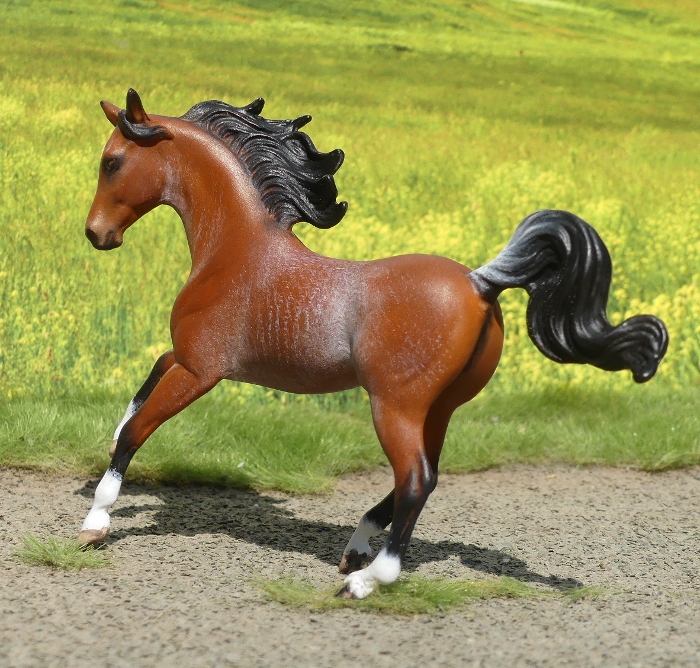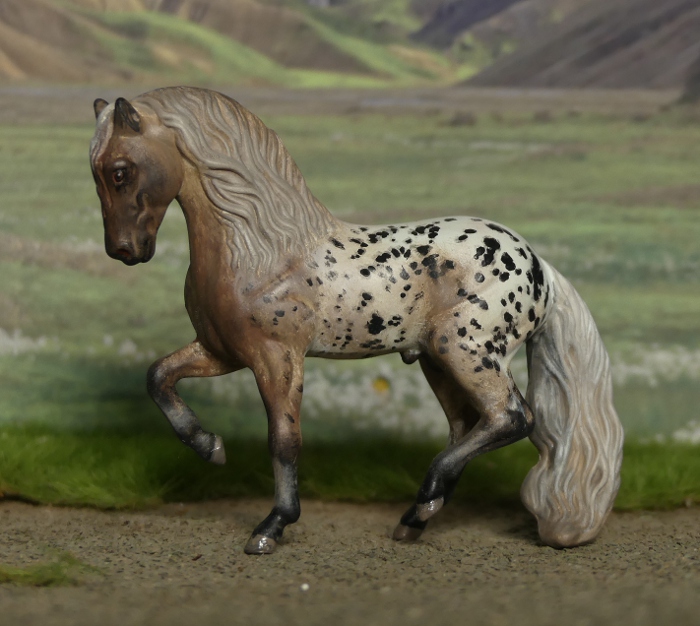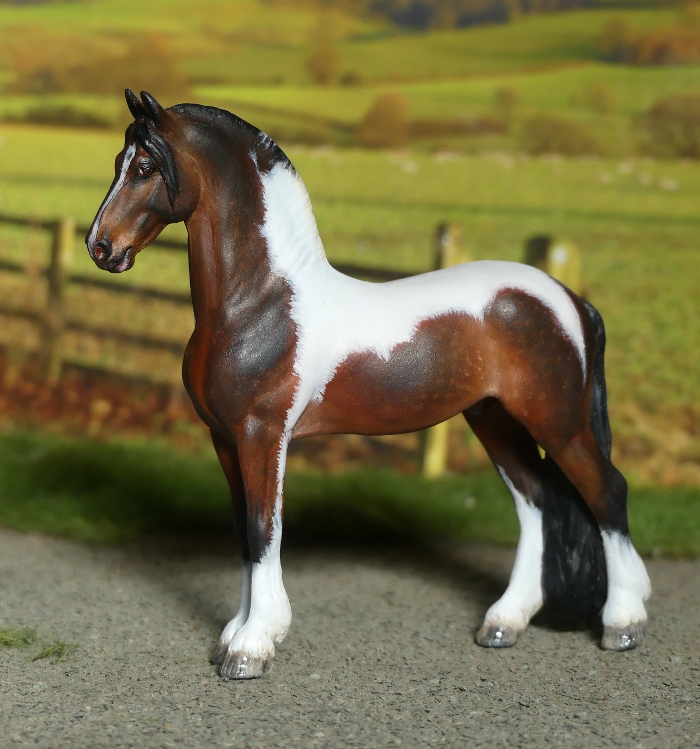I'm yet to be inspired to dig out the craft materials and make any tack, miniature props, or scenery, and I haven't sewn a rug for a very long time indeed!
I always say my creativity goes in phases, and I'm unable to do more than one thing at a time : if I'm writing, I won't be touching the paints. If I'm drawing, I won't be making any miniatures. If I'm painting, I forget I ever could draw, and all my ideas remain unwritten. But rather than seeing this as a useless disappointment, I just embrace whatever I do feel like I'm in the mood for, and my painting phase is carrying on far longer than they ever usually do, so this week I've got a few more customs to share.
Firstly, the horse I intended to paint last time I picked up this mould! I'm really not very good at painting what I had in mind when I set out (one of the many, many reasons I've never considered taking commissions!), some paintjobs just go off in a different direction part way through and I like the results too much to go and spoil it by insisting my original idea was better.
This one's called Bronzewing, and the markings are inspired by a skewbald I saw out competing cross country last year, I just liked the idea of the entirely white back view, as opposed to the flash down the sides of the quarters I more often see - and paint - on a more minimally marked tobiano.
One of my aims this year is to push a little more out of my coat colour comfort zone, or rather, extend that comfort zone so I feel competant tackling a wider range of colours.
Overo pintos are one of those colours which feels very 'other' to me, totally outside my little world of UK horsey experience and knowledge.
This, of course, goes for a lot of breeds - I don't travel the world, so I've never met a Lusitano, or an Icelandic, or a Peruvian paso, either. But their colours, and markings, aren't unfamiliar territory : the same bay I could paint on a TB would look at home on a Marwari. The greying I understand on a welsh pony, that works on an Andalusian, too. Dun for Norwegian fjords, well that's just the same as dun for Highlands but with a cooler haircut. Familar and well-understood white markings and patterns can, with a little research, be applied to lots of different breeds.
But overo? Nope, that's crazy!
It doesn't do what my mind says markings do, when sabino and tobiano are the only white-marked coats I ever see, the patterns I've been painting for years.
Tackling an overo meant hours spent googling through pictures, trying to 'learn' the likely shapes and spread of the white patches. My first one was fairly tame, with not a lot of pinto bits, so this time, I decided I had to be brave and go for a lot more white!
I'm pleased with how he turned out, I think the colour was more or less a success (although it'd take someone who actually understands overo the way I'm at home with tobiano to truly judge whether I'd done a decent job or not!), and I do think it suits the mould quite well, the action pose calls for something eyecatching. I've called him Diamond Creek Dazzler.
I finally found a little pot of blue paint in an old craft kit, so now I can do blue eyes without having to resort to colouring pencil over a white eye!
Here's another colour I'm not used to painting, but this time I've actually known several of them in person, the much more familiar sunburnt black! Some look practically bay in their faded stage, and because I've already got the OF black in this mould I didn't want them to be too alike, so I went quite heavy on the reddish shading - some sunburnt blacks have a much more subtle tint, to the point where you only really notice it if they're near a non-fading jet black horse to compare!
This angle is better to show the mould and pose, but doesn't bring out the colour quite so well. He's now named Romario, I'm doing quite well keeping up with naming this batch promptly!
Having done a couple of new colours, I decided to go for something else I'd never tried before, though pretty popular for model painting - a rabicano roan. Most commonly found in arabians and quarter horses, I picked a G3 stock horse and gave her a simple dark bay base coat, then got to work adding the roaning. First some white flicked on each flank with my thumb over a chunky paintbrush, then I picked out a finer brush and added the rib barring, lines following the hair whorl from belly to hip, few flecks of white on the quarters, throat, and behind each elbow. I finished it off by blending in the hand-painted hairs and adding the white top to the tail with some careful dry-brushing, gentle dusting of a very soft dense brush with not a lot of paint touched on the very tips of the hairs, so it leaves a faint smudge of white which increases with every pass of the brush.
This head-up, mouth-open pose is a bit odd from the side, but does make good characterful pictures from the front, like a horse who poses for the camera!
The bum-emphasising angle so favoured by real-life stock horse people! I've named this mare Plum Velvet, cos her colour reminds me of the sheen and lustre on dark velvety fabric.
Having thoroughly enjoyed one rabicano, I rummaged through the body box to find another suitable breed, and came up with this Magnolia arabian, one of my duplicates from the second series of blind bag mystery horses. This time I picked a brighter shade of bay as the base coat, and added the roaning in the same way as the first mare - it's showing up a little less because there's not the dark and light contrast, but I think the colour really suits the mould and it's far more interesting than she looked in plain bay part way through!
My first Magnolia custom, this was one of the moulds I was a bit unenthused by when first released, but the process of painting one, handling it and seeing it from all different angles, has made me like it more somehow. I did file down a couple of extremely overlong toes, though, and shortened both the ears a little bit! I'd like to get more of the mould eventually - perhaps one day if any full cases of series 2 mystery bags come up for sale cheap like the series 1 boxes did!
I've named her Lumina, a name which has been kicking about on my list for aaaages but I've painted a lot of geldings and stallions lately and was saving it up for a mare.
My supply of Stablemate bodies is starting to look seriously depleted, now, with how many I've done over the last few months, though I'm far from running out entirely I know I've used up all I'd got of certain moulds : I really need to lay them all out together and take stock of what's left in there, what I paint next will depend on managing to match remaining breeds to my colour ideas and inspirations. We'll see!

































